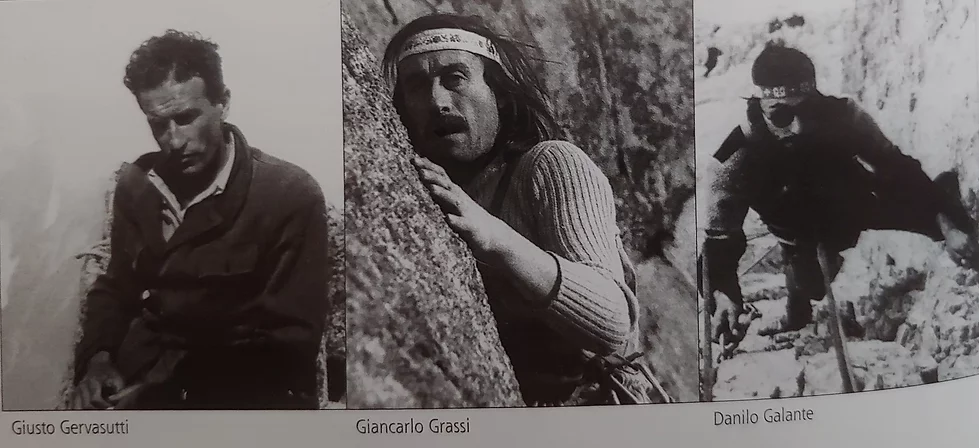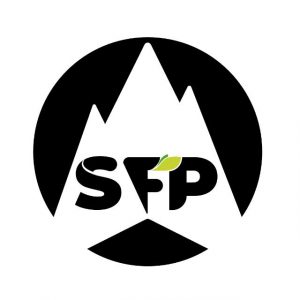1972: it’s the year of change. For the first time, the foothill walls begin to be considered.
The first attempts of Cotta and Saviane on the Ancesieu wall in the Forzo Valley, and Machetto and Gogna on the Scoglio di Mroz at the beginning of the Piantonetto Valley are recorded.
Almost simultaneously, the first ascent of the Caporal takes place, the work of the teams led by Motti and Manera: it’s the beginning of a new chapter.
1973: a mythical year in which the previous difficulty standards are surpassed with some symbolic climbs, the result of the New Morning philosophy elaborated by Gian Piero Motti.
Gogna (with Cerruti) continues the exploration of the Scoglio di Mroz with the Via della Torre Staccata, remarkably beautiful, but the achievement of the year is undoubtedly the ascent of the Sole Nascente al Caporal, by Motti, Grassi, and Kosterlitz.
More or less the same group tackles the Torre di Aimonin for the first time.
Galante and Grassi instead discover the Sergent and trace the Cannabis, a small masterpiece of free and artificial climbing.
Manera, riding the wave of enthusiasm, traces the Via della Rivoluzione on the Caporal, a masterpiece of mixed climbing.
1974: the exploration of the lower valley structures in the Balma Fiorant gorge intensifies, but the novelty is the free climbs by Galante, truly extreme and daring, a real leap in quality since the times of Gervasutti. Galante and Bonelli climb the Diedro del Mistero and the fessura della Disperazione al Sergent, the Diedro Nanchez al Caporal, probably touching the limit of VI superiore with scarce or no protection.
Manera explores the Parete delle Aquile and the Parete dei Falchi next to the Caporal, walls destined to remain forever in the shadow compared to Caporal and Sergent,
1975: compared to the previous years, it’s a year of stagnation where it seems there is very little new to say, and the significant routes of the year are those of Motti on the Caporal (Itaca nel sole) and Grassi on the Parete delle Aquile (Grotta Fiorita).

1976: new protagonists appear on the scene, and this is how the best things are done by Roberto Bonelli, on the Parete del Disertore of the Grande Ala, giving the impression of a certain bewilderment after the overwhelming events of the previous years. However, the will to continue the discourse left suspended by Galante, who had meanwhile disappeared in the mountains, is evident.
1977: another year of stagnation. The emerging figure on the opening scene is undoubtedly Isidoro Meneghin, who immediately stands out for some new routes on the Parete dei Falchi and on the Sergent (Nicchia delle Torture). Isidoro’s style is more alpine, far from the free-climbing that had inspired Motti’s group, and he does not disdain the massive use of aid climbing. However, many secondary walls bear Meneghin‘s signature as the first absolute explorer.
1978: Roberto Bonelli succeeds, after eight years of attempts, in repeating the Fessura Kosterlitz. Bonelli himself opens another route on the Parete del Disertore.
1979: the VII grade is finally reached by an emerging young talent on the rocks of the Caporal: Gabriele Beuchod climbs the Orecchio del Pachiderma directly in free, an undertaking that goes beyond the climbs of Kosterlitz and Galante.
Bonelli and Beuchod form a small group around them that quietly aims to continue exploring the valley according to the New Morning philosophy, without, however, seeking difficulty for its own sake.
1980: the stage is divided. On one side, the walls of the lower valley, where a new talented climber like Marco Bernardi enters the scene. On the other hand, the mountain, where Manera and Meneghin continue the exploration of the group and try to bring the enthusiasm of the times of Caporal and Sergent to higher altitudes. Soon, Grassi will join them, starting a new exploratory period.
Bernardi climbs the Diedro Nanchez al Caporal in free, another VII grade, then the Camino Bernardi al Sergent, unprotected VII.
Then, with Grassi, he reaches the same grade in the mountains, on the Monte Nero, proving to be a complete climber.
Meanwhile,
1982: The young followers of Bernardi open Rattle Snake at Caporal, while Manolo and Bassi themselves free the route Cochise al Cubo. Manolo then amazes everyone with an onsight ascent of Incastro Amaro, Bernardi’s 7a, who, in the meantime, has dedicated himself to the emerging sport climbing. Meanwhile, Berhault and Edlinger, the two icons of the moment, make their appearance in the valley.
1983: This could be considered a neoclassical year, marking a return to traditional alpinism with new protagonists, despite the expectation of a shift towards sport climbing due to the influence of climbers like Manolo and Bernardi in the previous years.
The walls of Caporal and Sergent come back into fashion thanks to the Turin climbers Caneparo and Oviglia, who stand out with a series of traditional climbs.
The very young Roberto Mochino takes 36 hours for a big artificial route on Sergent, while against the current, the Swiss climber Marco Pedrini uses bolts and top-down climbing to reach grade IX on Caporal. On the same wall, Michel Faquet achieves the first free ascent of Tempi Moderni: VIII grade on poor-quality pitons.
1984: After winter climbing Monte Castello, Daniele Caneparo dedicates himself to new routes on the lower valley walls, reviving Sergent and Caporal with a series of beautiful climbs in the company of Oviglia, always following the traditional lines.
While Gian Piero Motti tragically disappears, bolts appear on Sergent, planted from above as the new wind from France begins to blow fiercely.
1985: Bolts have arrived, but they take root sparingly in Gran Paradiso, only on the Sergent wall. The character of the year is the eclectic Roberto Mochino, capable of transitioning from winter climbing to the Long Walk of the Comanches (Caporal) with bivouac on stirrups to a free climb on bolts, passing through a big artificial route.
In 1985, he manages to jump from the precarious artificial climb of Cocaine to the bolts placed by Oviglia and Caneparo on Charlot, at the Parete del Disertore.
1986: A transitional year, characterized in the lower valley by some important free ascents by Oviglia, who, before moving permanently to Sardinia, repeats and frees everything, from the heavily bolted Miroir Doc to Grotta Fiorita to the Aquile Wall and Beuchod’s routes. Meanwhile, Caneparo continues with the openings, neglecting bolts and moving to the few sectors still unexplored in the valley.
Mochino himself free climbs Cannabis and Angels of Death on Sergent, matching the IX grade heights touched by Pedrini a few years earlier.
1987: It is a year scarce in climbs, and the few completed ones still don’t use bolts, as has been the case for some time in the Mont Blanc massif.
1988: Another year of almost total stagnation. Bolts, however, are on the horizon and timidly begin to appear in the Vallone di Forzo on long routes. The author is the guide Nazareno Valerio, who, however, still descends from above to place them, just like Pedrini did on Caporal four years earlier.

1989: A year of great news and climbs. The prophesied Bolting Age officially begins, although the true awakening will take place in the early 90s, thanks to Lele Bortot and Fausto De Stefani, who will bring the Gran Paradiso walls to light with hundreds of routes.
This opens a parenthesis that the following article will cover in detail.

